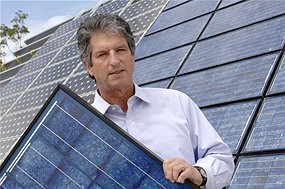Leading Australian research in solar energy has produced new photovoltaic solar cells that recently broke the 20% barrier for efficiency in capturing the sun’s energy, the highest ever efficiency for a low-cost commercial silicon solar cell.
The solar cells reached a production capacity last year of 0.5 gigawatts, worth more than US$1billion a year. This is enough to power 300,000 average homes with eight solar panels each for at least 25 years.
Pluto technology, as it is patented, was developed by Professors Martin Green and Stuart Wenham at the ARC Photovoltaics Centre for Excellence in close collaboration with the world’s largest solar cell manufacturer, Suntech-Power.
“We recently broke through the 20 per cent target for solar cell efficiency, which many experts thought was impossible and we’ve significantly lowered the costs compared to other technologies,” says Green from the University of New South Wales.
Green believes this outstanding result was achieved through collaboration with Australian company Suntech-Power. “We brought our photovoltaic knowhow together with their manufacturing expertise, which used new tools and processes to create solar cells ten times the size of our lab-scale devices.”
Suntech-Power’s expertise was important for lowering the costs of the cells by using cheaper processing methods, like laser patterning, and replacing expensive silver and titanium parts with less expensive materials.
“Without this collaboration and its funding through the Australian Solar Institute, Pluto would have remained a lab prototype rather than a commercial reality,” says Wenham.
“Pluto is rapidly increasing its market share with many companies around the world looking to replace their existing 30 year-old production technologies.”
International studies predict that the present $100 billion/year photovoltaic industry will grow to well in excess of a $trillion/year as they become the major supplier of the world’s electrical energy needs.
